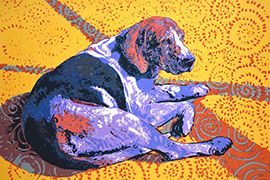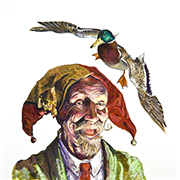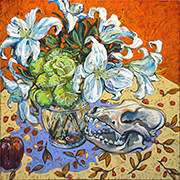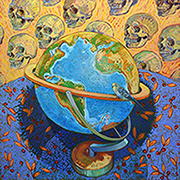Leslie Shiels makes paintings and prints as her own response to life, to what she sees around her in solid fact and in underlying meaning. Talking with her, I had the feeling that she just can’t help it; when something interests her, bothers her, gives her an idea, she wants to make art of it. And so she does. As it happens, her interests are considerable.
She has been intrigued with dogs for some time. A recent show of her serigraphs in C-Link Gallery at Brazee Street Studios focused on dogs of the long-eared hound type along with a few cats and in one surprising piece a turtle seemingly on the move beneath its patterned shell, against an orangish background.
This show included her use of dizygotic works, a concept new to me. It means pairs of works, one left-looking and one right. She does this with dogs, chickens, horses as subjects. Backgrounds frequently reverse tone: what’s warm for one is cool for the other. Her work here was full of fancy: in one piece a mouse is perched on the top of what seems to be a Corinthian capital, and in another a trim little hound lopes along, birds above and what might be fish below. I also liked her look at a robin who encounters sundry wild life. Shiels looks at nature the way some of us watch people.
The Brazee show was interesting in that it also presented a lesser known segment of the work of Kevin Kelly, the contrast between the two artists setting off each of them. Kelly, known for his colorful Neo/Post Pop style, was represented there by calm drawings and serigraphs, mostly black and white, conveying entire landscapes by suggestion. The works were seen in adjoining galleries, one devoted to Shiels and one to Kelly, effectively heightening the impact of each.
Later I met Shiels in her studio to discuss her work and career in greater detail. She was wearing black coveralls, no doubt her working clothes as liberally paint-smeared, has shoulder-length brown hair and wears dark-rimmed glasses. The studio is one of the largest I’ve encountered, brimming with art and the cheerful disarray that constitutes a working space. She has what she calls “the back end” of the fourth floor at Carl Solway studios, 424 Findlay Street, a large, high space windowed on three sides and crammed with art – stacked, leaning, finished and unfinished. A small seating area has been fashioned somewhere in the middle, couch and a couple of chairs, and a hound dog is in residence as well. The dog came from the pound, she said, and is a mix of standard poodle and St. Bernard and surely is model for some of the dogs in the Brazee show’s serigraphs. My notes say she told me he sleeps on the bed in the studio. I didn’t see a bed, but no doubt it’s there, somewhere in the well-filled space. She has a fridge, where flowers can be kept fresh before serving as models for a painting.
Shiels has been at the Findlay Street studio more than ten years and says that originally she really wanted only about half that much room but this was available and seemed suitable. Her husband, who carried her works up and down stairs whenever they went in or out of her old studio, finds the capacious freight elevator at Solway a considerable improvement, she added.
Shiels’ husband’s bow and arrow hunting also is reflected in the studio and indirectly in her work. Mounted deer heads serve as surprising adjuncts in this busy space, and of course deer themselves appear in some of her work. “We consumed the deer,” she said. “Things consumed make you aware of who you are. . .going to the store is different from knowing that something had to die for your nourishment. We’ve lost connection.” Her work, she feels, honors the connection.
Landscapes, birds and people also figure in Shiels paintings and prints. Skulls turn up now and then in her work, as memento mori, and she has an actual skull of a Great Dane at hand. The landscapes are perhaps as literal as she anything she turns out but they convey a clear sense of art rather than record. Her interest is as strongly in the act of painting as in reproducing what she sees.
A whole series of bird/people paintings made up a show called “Bird Heads” at The Carnegie Galleries in Covington in 2009. Director Bill Seitz’s catalog introduction describes these startling but engaging paintings as “an insightful window into human personalities. . .(they) allow the viewer to interpret the dynamics of the relationship. . .using people from around the world to investigate our differences and similarities.” The people are shown head and shoulders, the birds hover above or even sit on their heads. Both birds and people are distinctively themselves; the birds can be identified by species and in a way so can the people. Their individual and distinctive physiognomy says much about who each is and perhaps what he/she does. As it happens, a selection of “Bird Heads” enlivens the walls at Jean Robert’s Table restaurant, 713 Vine Street in downtown Cincinnati right now.
But making the painting is the point. “It’s a discipline,” she told me. “Magical accidents come from constant work. I like to let it rip. . .so that sometimes my own response is ‘where did THAT come from?’” She is meticulous, and talked about mixing paints endlessly to get precise shades – “there are ten dark greens in that grain,” she said pointing to a detail. She had earlier called herself “sort of a compulsive person,” an attribute her art clearly profits from.
We talked more about painting, how she can start work feeling irritated and just keep painting until she’s not irritated any more. “I paint myself out of it.” Life, she finds, quickens as it passes. “The older you get the faster it goes. Everything is changing so quickly.” Then she adds, with clear satisfaction, “And I get to watch.” But of course she doesn’t just watch. She makes art that lets us know something more about where we are.
Shiels list of exhibitions, beginning in 1990, is impressively long and continues, as she is part of the current traveling show Three Voices: Conversations on Life & Conflict on view May 20-August 13 at the Decorative Arts Museum of Ohio at Lancaster. Many of the exhibitions have been in the Ohio/Kentucky region but she’s also been shown as far afield as Louisiana, Wisconsin, Colorado, California, Texas and Bermuda.
–Jane Durrell







